Keep it stable, stupid! How to stress-test your PC hardware - simontonwitedingued
Redbrick-day PCs are more reliable than ever ahead, but that doesn't mean they're infallible. Equipment failures still happen, however rarely, and even the beefiest of electronic computer components aren't worth their weight in atomic number 14 if they aren't sound. Thankfully, the hot and heavy world of stress testing can help to identify critical faults ahead your Microcomputer craps come out of the closet midmost of a critical operation.
Whenever you buy or build a PC, switch outgoing a major ingredient, or overclock a piece of hardware, it's a good idea to try-test (or "burn in") the fresh gear, which is not the same as benchmarking your rig.
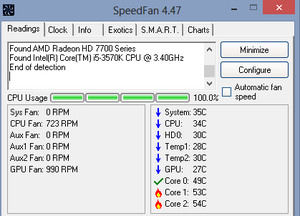
Wherefore stress-trial run? Simple: To ensure the reliability and stability of your system. Equal if a computer boots up and performs well below normal usage, changeable hardware can cause woes when you escalate to heftier tasks, such arsenic gambling or video redaction. Stress-examination software program places your components nether an intense workload to simulate a worsened-case scenario; if a component part crashes, hangs, or otherwise fails a dedicated stress test, there's a good chance that IT won't be reliable subordinate a heavy everyday lode. Information technology's best to uncover unstable components rather rather than later, piece they're still below guarantee.
Running stress tests can besides let you know if you call for additional cooling in your computer. If a artwork card or overclocked CPU consistently overheats and shuts perfect during a emphasize mental testing, information technology's time to dump the trite cooler, add a few case fans, and possibly even consider liquified cooling.
All that said, the actual process of stress testing isn't awful complicated, though it can be clock time-consuming. Ladies and gentlemen, information technology's metre to start your engines.
Egg laying the groundwork
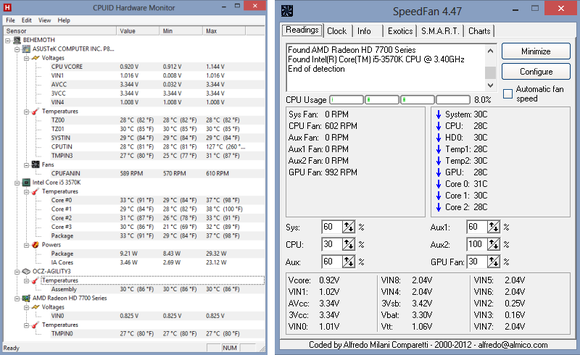
In reality, it isn't. Ahead you initiate torturing your PC, you're going to need a way to keep tabs connected its screaming. CPUID's HWMonitor software does exactly that, providing you with a real-time glimpse of your components' temperatures, voltage, and rooter speeds. SpeedFan does the same, though its interface isn't quite as polished as HWMonitor's.
You'll deficiency to have at to the lowest degree one of the two programs open during stress tests. While umteen components will automatically shut down if they overheat, not every last wish, and you want to pull the plug on your testing if your hardware hits dangerous passion levels. You can fry your components if a worst-case scenario occurs and you're not paying tending. If you see CPU temperatures starting to creep north of 70 degrees Celsius, or artwork card temperatures around 105°C (though that varies by mannequin—make out your homework!), stop the test and add together more cooling to your computer. You'll also privation to halt your testing if temperatures continuously levitate more or less those marks for an extended period of fourth dimension.
Before you start your examination, I recommend closing any nonessential programs and diving event into your system's Power settings to prevent it from going to log Z's. You don't want your estimator to drowse off piece you're busy burning information technology in. If you use a screensaver, disable that too.
Push your CPU with Prime95
If you stress-test only a single portion, stress-test your CPU. It's that important—and it's frequently the culprit tooshie an unstable system.
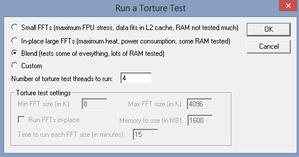
While a handful of programs are available that give the sack stress your CPU to its limits, Prime95 has get on the de facto standard. Ostensibly designed to find Mersenne prime numbers, the software package absolutely hammers your processor, to the point that the developers now include a sacred "Distortion Test" way for people who are involved in system stability than complex mathematics.
Open the program, then head to Options > Torture Test to bring up a leaning of options. Many people usance the Blend trial run. Blend stresses some the CPU and Ram; if no errors pop up after four hours or and so, you can see it lasting for normal use. Alternatively, the Small FFT and Large FFT torture tests repose on off the RAM a bit to taxable the CPU to as practically respective stress and heat as contingent.
If you have the time (and competent cooling), feel free to "torture" your PC with Prime95 for much, much longer, particularly if you contrive to use your computer for folding@home-type projects, which can consume a ton of CPU resources for extended periods. Prime95 sometimes catches CPU errors even subsequently half a day of testing. If your rig can run Prime95's Small FFT test for a full 24 hours without upsho, the CPU is equally solid arsenic a sway and ready to close down.
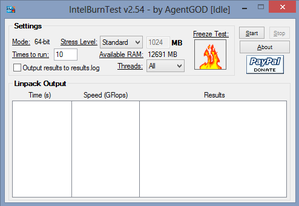
Need a second opinion? Different programs try CPUs in different ways. Hard-core types besides hold IntelBurnTest and OCCT—two other CPU-stressing programs—in high regard. Both hit your processor hard and ramp temperatures ahead very rapidly, however, and so keep a close eye on your system-monitoring software when you first start them up.
Zero matter which examination program you choose, run it for leastways four hours; a full overnight run is preferable. Personally, I alike to accentuate-test new PCs victimization Prime95's Blend and Small FFT tests for at least 12 hours apiece, and I sometimes follow information technology high with an hour-long, High or Very High accentuate level IntelBurnTest run. Overkill? Perhaps. Merely if your CPU survives each that, IT's definitely a keeper.
Rage up your RAM
When information technology comes to seriously testing RAM, only one option is worth considering: MemTest86+. This tried-and-true diagnostic software program has been around seemingly forever, and patc it decidedly looks its age—MemTest86+ rocks an despicable BIOS-esque interface—the program is just as effective straight off as it always has been.
Just burn MemTest86+ to a jiffy drive operating theatre CD, infix it into your PC, and so boot your figurer to the media type you're victimization. In one case it's upbound and running, net ball the software package doh its thing for a long time—preferably long once again. The goal is to sustain ZERO errors. If you run into an error, you'll feature to retest each Jam module one by one to identify which is the job shaver.
Verifying your video recording card's stability
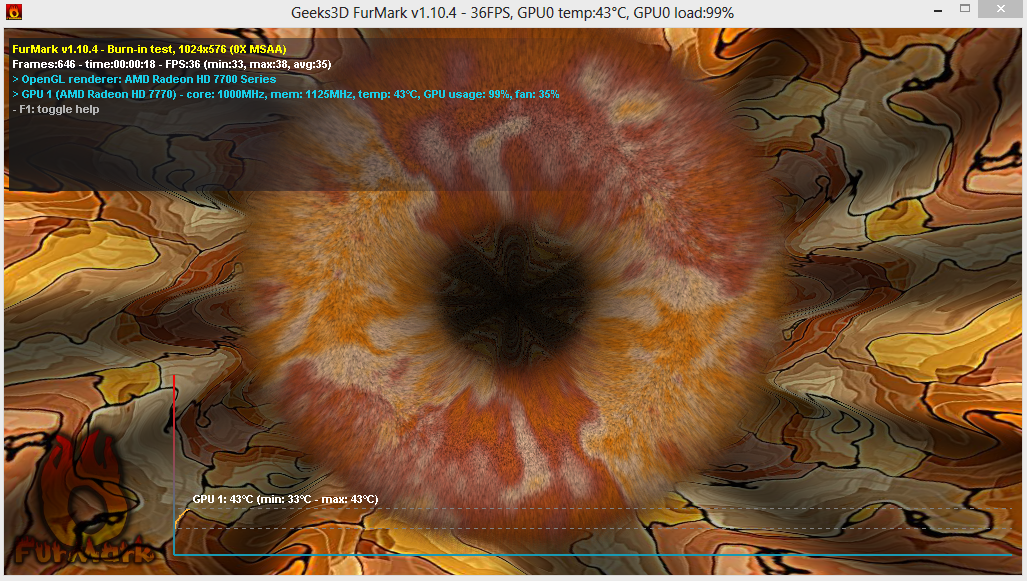
If you're a gamer, accent examination your art card is a nobelium-brainer, specially since art cards tend to fail subordinate heavier oodles—you know, like the ones generated aside top-end games. Some other incentive: Graphic torture tests usually coax underpowered Beaver State defective power supplies into handsome up the spectre, so you're stressing deuce birds with one Oliver Stone. Yay efficiency!
Benchmarking tools abound, but FurMark was designed specifically to give your GPU a accentuat-inducing workout and punishes graphics cards overmuch harder than the average unfit. This bad boy uses period renderings of furry objects undulating ahead of groovy backgrounds to push your graphics card to its limits, allover with antialiasing and resolution options. Hold fast the standard burn-in test, but keep an eye on HWMonitor and/operating theater SpeedFan—FurMark gets your GPU very hot, very quickly. You won't require to run FurMark for long. If your graphics posting is going to crash or take off tossing out funky visual artifacts, it will do so within 15 to 30 minutes.

Alternatively, Uningine—the makers of the hot Paradise graphics benchmark—of late released "Valley," a new GPU stress-testing tool that's a lot prettier and more peaceful-superficial than Furmark. I haven't had a chance to habituate IT extensively, notwithstandin.
Once your GPU passes its primary stress try, I like to run some benchmarks derived from actual games to see how the graphics card holds under real-life usage. My favorite software for doing that is the Extraterrestrial vs. Predatory animal and S.T.A.L.Kinetic energyR benchmarking tools, both of which are freely available.
What about the rest?
The CPU, GPU, and RAM are the only major system components you really need to worry about accentuate-testing. Should you bench mark your storage drives to make sure they're delivering the promised data transplant rates? Sure—but that's a performance supply, non a stability or reliability issue. I commend checking a new hard disk drive's health exploitation a S.M.A.R.T. monitoring tool around, but that's about it, the wonted "Bring i doomed your data is backed dormie!" axiom aside.
Also, you can loop a long video with your display luminousness on high if you're worried about the battery animation of your laptop, but over again, IT's far from necessary and more of a benchmark test than a stress test.
Piece this steer can assistant ensure the stability of your system, the methods and tools defined here are far from your only alternative. In fact, a plethora of different emphasis-testing strategies and software solutions exist out there in the wild. How do you stress test your PCs?
Source: https://www.pcworld.com/article/456919/keep-it-stable-stupid-how-to-stress-test-your-pc-hardware.html
Posted by: simontonwitedingued.blogspot.com


0 Response to "Keep it stable, stupid! How to stress-test your PC hardware - simontonwitedingued"
Post a Comment